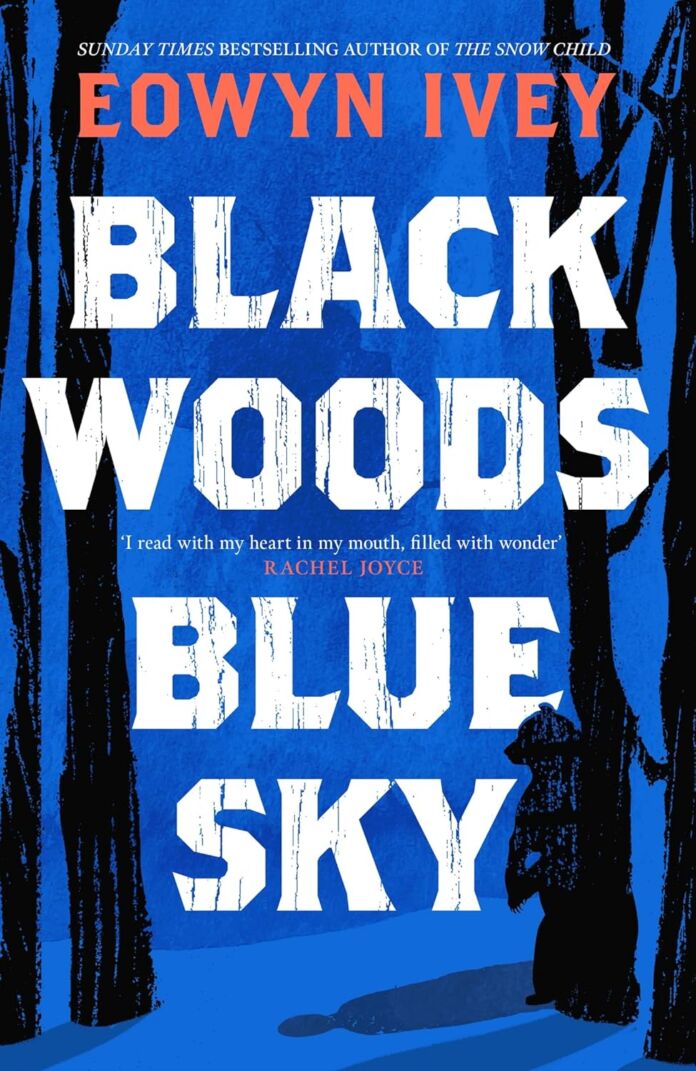In her latest novel Black Woods, Blue Sky, Pulitzer Prize finalist Eowyn Ivey returns to the untamed landscapes of Alaska, weaving a mesmerizing tale that blends elements of dark fairy tales with the raw realities of wilderness living. Following the success of her previous works The Snow Child and To the Bright Edge of the World, Ivey once again demonstrates her masterful ability to paint Alaska not just as a setting, but as a living, breathing character that shapes and transforms those who dare to embrace its wild heart.
Plot Overview: A Journey into the Unknown
The story follows Birdie, a single mother working as a waitress at the Wolverine Lodge, who dreams of escaping the constraints of civilization. When she meets the mysterious and scarred Arthur Nielsen, who lives in isolation on the far side of the Wolverine River, she sees an opportunity for both herself and her six-year-old daughter Emaleen to start fresh. Despite warnings from those around her, Birdie moves them to Arthur’s remote cabin, far from modern conveniences and human contact.
What begins as an idyllic adventure – fishing for salmon, picking berries, and climbing mountains under endless summer skies – slowly reveals itself to be something far more complex and dangerous. Arthur harbors a supernatural secret that challenges the boundaries between man and beast, leading to a devastating climax that forever changes all their lives.
Character Analysis: Complex Portraits of Human Nature
Birdie: A Mother on the Edge
Ivey’s portrayal of Birdie is masterfully nuanced. She’s neither hero nor villain, but a deeply flawed woman trying to navigate single motherhood while wrestling with her own desires for freedom and authenticity. Her character arc is both compelling and frustrating—we understand her yearning to break free from societal constraints, even as we question her choices as a mother.
Arthur Nielsen: The Beast Within
Arthur emerges as one of the most complex characters in contemporary fiction. His struggle with his dual nature – part man, part bear – serves as a powerful metaphor for the internal battles we all face between our civilized facades and primal instincts. The author handles his transformation scenes with remarkable restraint, making them all the more powerful.
Emaleen: The Heart of the Story
Through Emaleen’s eyes, we experience both the wonder and terror of their new life. Her character serves as our moral compass, and her journey from innocent child to survivor forms the emotional core of the novel. The scenes where she processes trauma through her imagination are particularly poignant.
Writing Style: Mastery of Craft
Ivey’s prose is a perfect marriage of lyrical beauty and stark realism. Her descriptions of the Alaskan wilderness are breathtaking without being purple, and she handles the supernatural elements with a light touch that makes them feel natural and believable. The pacing, however, occasionally suffers in the middle sections, where the domestic scenes sometimes overshadow the building tension.
Themes and Symbolism
The Wild vs. Civilization
The novel expertly explores the tension between wilderness and civilization, questioning whether it’s possible to truly bridge these two worlds. The Wolverine River serves as both literal and metaphorical boundary between these realms.
Transformation and Identity
The theme of transformation runs throughout the novel, not just in Arthur’s physical changes but in how all characters must confront their true natures. The author challenges us to consider what parts of ourselves we keep caged and what happens when we let them free.
Mother-Daughter Bonds
The relationship between Birdie and Emaleen forms the heart of the story, exploring how love can both heal and harm. Their bond is tested against the backdrop of survival and supernatural elements.
Strengths and Weaknesses
What Works
- Masterful world-building that makes Alaska feel alive and present
- Complex, morally ambiguous characters that defy easy categorization
- Beautiful prose that enhances rather than overshadows the story
- Seamless blend of realistic and supernatural elements
Areas for Improvement
- Pacing issues in the middle section could be tighter
- Some secondary characters feel underdeveloped
- The ending, while powerful, might leave some readers wanting more resolution
Analysis of Key Scenes
The novel’s pivotal moments are handled with exceptional skill. The first revelation of Arthur’s true nature is particularly well-crafted, building tension through subtle hints rather than explicit description. The final confrontation on the mountain ridge is both heartbreaking and inevitable, demonstrating Ivey’s ability to bring multiple story threads together for maximum emotional impact.
Comparison to Other Works
While Black Woods, Blue Sky shares DNA with Angela Carter’s fairy tale retellings and Annie Proulx’s Wyoming stories, it carves out its own unique territory. Fans of Ivey’s previous work will recognize her talent for mixing magical realism with frontier narrative, but this novel takes darker turns than The Snow Child.
Impact and Relevance
The novel’s themes of environmental connection, maternal love, and the price of freedom resonate strongly in our current cultural moment. Ivey raises important questions about our relationship with nature and the costs of trying to tame both the wilderness around us and within us.
Final Verdict
Black Woods, Blue Sky is a remarkable achievement that confirms Ivey’s place as one of our most interesting contemporary writers. While not without its flaws, the novel’s ambitious scope, beautiful prose, and emotional depth make it a compelling read. “Black Woods, Blue Sky” is a good read for its bold storytelling and masterful execution of complex themes.
Recommended For
- Fans of literary fiction with supernatural elements
- Readers who enjoy wilderness narratives
- Those who appreciate complex mother-daughter stories
- Anyone interested in modern fairy tale retellings
Reading Experience Notes
The novel is best savored slowly, allowing time to absorb the rich descriptions and layered meanings. The supernatural elements are handled with such skill that they feel like a natural extension of the wilderness setting rather than fantastic intrusions.
Conclusion: A Worthy Addition to the Modern Canon
Black Woods, Blue Sky is a powerful exploration of love, wilderness, and the prices we pay for freedom. While it may not be for everyone – particularly those who prefer their fiction firmly grounded in reality – it offers rich rewards for readers willing to follow Ivey into the dark woods of her imagination. The novel confirms her status as a unique voice in American literature, one who continues to push boundaries while remaining true to her Alaskan roots.





